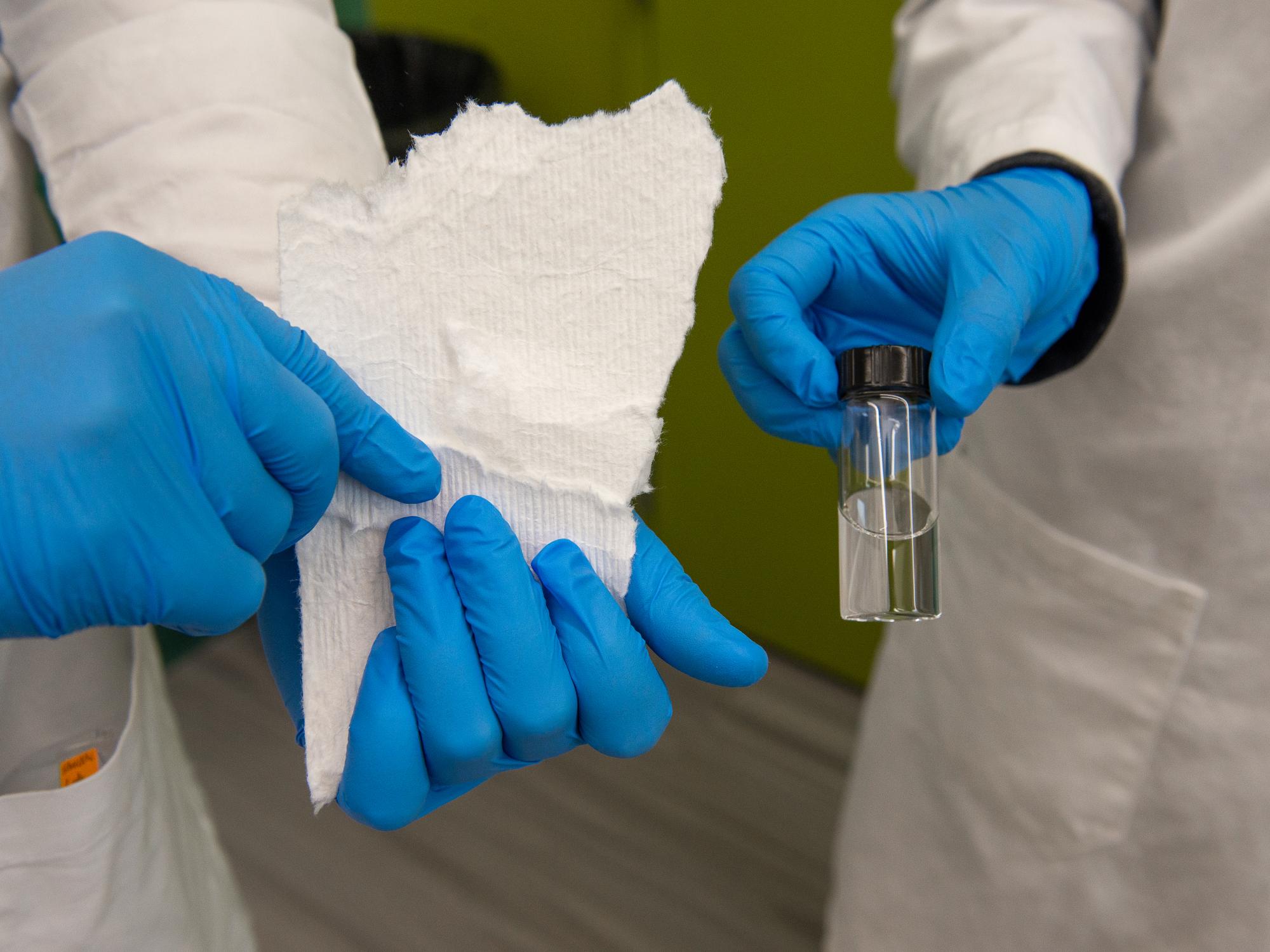eNews 2021
Battery metals from mine waste: Potential economic benefits for the commonwealth

UNIVERSITY PARK, Pa. — Pennsylvania has a long history of mining and metallurgical activities dating to the Industrial Revolution that helped fuel the economy of the commonwealth and the nation. Coal markets have waned recently due to the transition away from coal to other energy sources, leading to many economically distressed areas in the state. New findings by a team led by Penn State researchers suggest potential economic opportunities from the domestic production of critical minerals. The team evaluated cobalt and manganese from the byproducts of mining and metallurgy from past industrial activities.
“The recovery and sale of cobalt and manganese from these materials can provide economic opportunities in distressed areas of Pennsylvania and revenues, when integrated with the reclamation of mines and industrial sites hosting the materials, to help cover reclamation costs,” said Pete Rozelle, lead author on the report and adviser on mineral resources to Penn State’s College of Earth and Mineral Sciences and retired headquarters programs manager for the U.S. Department of Energy.
Salvaging rare earth elements from electronic waste

UNIVERSITY PARK, Pa. — Manufacturers rely on rare earth elements, like neodymium, to create strong magnets used in motors for electronics including hybrid cars, aircraft generators, loudspeakers, hard drives and in-ear headphones. But mineral deposits containing neodymium are hard to reach and are found in just a few places on Earth.
With rising need for neodymium from several industries, attention has turned to recycling the elements found in old computers and printed circuit boards, otherwise known as electronic waste, to meet demand. But separating the valuable elements from other minerals and components found in e-waste proves to be a challenge.
In a recent paper in the Chemical Engineering Journal, Amir Sheikhi, assistant professor of chemical engineering and biomedical engineering, at Penn State, details a new nanotechnology to separate neodymium using plant cellulose, which is found in paper, cotton and pulp. Patrictia Wamea, a former member of Sheikhi’s lab who graduated in May with a master of science degree, co-authored the paper and earned the Penn State Department of Chemical Engineering's annual Best Paper Award in fall 2021 for her contributions.
Engineers to sustainably mine rare earth elements from fertilizer byproduct
UNIVERSITY PARK, Pa. — Despite their name, rare earth elements are not actually that rare. The 17 metallic elements are ubiquitous in nature and are becoming even more common in technology, as a critical component of microchips and more. The “rare” description pertains to how difficult they are to extract into a useable form. The normal technique to pull them from composite minerals is typically energy intensive and produces significant carbon emissions, and a large portion of rare earth elements are lost in waste from other industrial processes.
To develop a more sustainable process that can retrieve rare earth elements from phosphogypsum, a byproduct of fertilizer production, Penn State researchers were awarded a four-year, $571,658 National Science Foundation grant as part of a collaboration with Case Western Reserve University and Clemson University totaling $1.7 million in funding. Each university is independently funded to pursue a specific aspect of the project, but the project is centrally coordinated by researchers at Case Western Reserve. Lauren Greenlee, associate professor of chemical engineering, is leading the Penn State effort with co-principal investigator Rui Shi, assistant professor of chemical engineering.
Protein could unlock new sources of rare-earth elements
A protein that binds rare-earth elements could be used to extract and separate these valuable metals from low-grade sources, such as coal ash or electronic waste (ACS Cent. Sci. 2021, DOI: 10.1021/acscentsci.1c00724).
The rare-earth elements (REEs) include the 15 lanthanides, along with scandium and yttrium, and many are in high demand for products such as electric vehicles, wind turbines, and light-emitting diodes. Although most REEs are not particularly rare, they tend to be spread thinly throughout Earth’s crust rather than concentrated in a single place, which limits opportunities for mining them at scale. And the elements are often found together in the ground and share similar chemistry, requiring separation processes that involve large amounts of energy and organic solvents.
New, environmentally friendly method to extract and separate rare earth elements
UNIVERSITY PARK, Pa. — A new method improves the extraction and separation of rare earth elements — a group of 17 chemical elements critical for technologies such as smart phones and electric car batteries — from unconventional sources. New research led by scientists at Penn State and the Lawrence Livermore National Laboratory (LLNL) demonstrates how a protein isolated from bacteria can provide a more environmentally friendly way to extract these metals and to separate them from other metals and from each other. The method could eventually be scaled up to help develop a domestic supply of rare earth metals from industrial waste and electronics due to be recycled.
“In order to meet the increasing demand for rare earth elements for use in emerging clean energy technologies, we need to address several challenges in the supply chain,” said Joseph Cotruvo Jr., assistant professor and Louis Martarano Career Development Professor of Chemistry at Penn State, a member of Penn State’s Center for Critical Minerals, and co-corresponding author of the study. “This includes improving the efficiency and alleviating the environmental burden of the extraction and separation processes for these metals. In this study, we demonstrate a promising new method using a natural protein that could be scaled up to extract and separate rare earth elements from low-grade sources, including industrial wastes.”
New sensor can detect valuable rare earth element in nontraditional sources
UNIVERSITY PARK, Pa. — A new luminescent sensor can detect terbium, a valuable rare earth element, from complex environmental samples like acid mine waste. The sensor, developed by researchers at Penn State, takes advantage of a protein that very specifically binds to rare earth elements and could be harnessed to help develop a domestic supply of these metals, which are used in technologies such as smart phones, electric car batteries, and energy efficient lighting. A paper describing the sensor appears Aug. 25 in the Journal of the American Chemical Society.
Terbium, one of the rarest of the rare earth elements, produces the green color in cell phone displays and is also used in high-efficiency lighting and solid-state devices. However, there are a variety of chemical, environmental and political challenges to obtaining terbium and other rare earth elements from the environment. Developing new sources of these metals also requires robust detection methods, which poses another challenge. For example, the gold standard method of detecting rare earth elements in a sample — a type of mass spectrometry called ICP-MS — is expensive and not portable. Portable methods, however, are not as sensitive and do not perform well in complex environmental samples, where acidic conditions and other metals can interfere with detection.
Penn State to lead critical minerals consortium powered by $1.2 million from DOE
UNIVERSITY PARK, Pa. — A region famous for the coal that once fueled a growing nation is now the focus of a $1.2 million project, led by Penn State researchers, aimed at establishing domestic supplies of critical minerals needed to produce modern technology from cell phones to fighter jets.
Penn State will lead the Consortium to Assess Northern Appalachia Resource Yield (CANARY) to assess and catalog northern Appalachian-basin critical mineral resources and waste streams; develop strategies to recover the materials from these streams; and identify potential supply-chain or technology gaps that will need to be addressed. The project, funded by the U.S. Department of Energy, is part of a broader, national effort to produce rare-earth elements and critical minerals.
Materia USA Awarded Option 1 of U.S. Department of Energy Contract to Advance Unconventional Critical Mineral Recoveries
Inwood, NY (April 30, 2021) – Materia-USA, a next-generation developer for rare earth and critical mineral projects in the United States, announced today that the company has been awarded Option 1 (Second Phase) of a contract from the U.S. Department of Energy’s National Energy Technology Laboratory (NETL). Continuation of the contract will fund a feasibility study, which follows the successful completion of Materia’s initial conceptual designs for a facility that will conduct reclamation of rare earths and critical minerals from an unconventional feedstock - in this case, coal measure underclay’s in central Pennsylvania. Work will commence on May 3, 2021.
The first phase of the DOE-funded work focused on Materia’s conceptual design for rare earths and other critical minerals reclamation through unconventional methods utilizing coal-based resources. Building on this conceptual design, the feasibility study will detail the economic benefits of the concept, in addition to the environmental impact of the design through a life cycle analysis (LCA) of greenhouse gas emissions (GHGe) in partnership with the Global Waste-to-Energy Research and Technology Council (WtERT).
Energy Fuels and Team from Penn State University Awarded Additional $1.75 Million by U.S. Department of Energy for Rare Earth Feasibility Study
LAKEWOOD, Colo., /CNW/ - Energy Fuels Inc. (NYSE: UUUU) (TSX: EFR) ("Energy Fuels" or the "Company") is pleased to announce that the U.S. Department of Energy ("DOE") Office of Fossil Energy and National Energy Technology Laboratory has exercised their option to award Energy Fuels, working with a team from Penn State University, an additional $1.75 million to complete a feasibility study ("Feasibility Study") on the production of rare earth element ("REE") products from natural coal-based resources, as well as from other materials such as REE-containing ores like the natural monazite ore ("Monazite") the Company is currently processing at its White Mesa Mill in Utah.
This award follows the DOE providing Energy Fuels a $150,000 contract in 2020 for the successful completion of a conceptual design for the same initiative, resulting in a total award to Energy Fuels of $1.9 million. The Feasibility Study is intended to support a cost estimate for the production of individually separated rare earth oxides and rare earth metals and alloys from coal-based resources or other resources, including Monazite, within the U.S., with a focus on REEs for the production of commodity and defense-related products.
Texas Mineral Resources Consortium Awarded Second Phase of U.S. Department of Energy (DOE) Contract Targeting Production of Mixed Rare Earth Oxides from Pennsylvania Coal-Based Resources
Texas Mineral Resources Corp. (TMRC), an exploration company targeting the heavy rare earths and a variety of other high-value critical elements and industrial minerals, is pleased to announce the Department of Energy’s (DOE) National Energy Technical Laboratory (“NETL”) has selected a Texas Mineral Resources-led consortium to continue a contract targeting the production of rare earths from Pennsylvania coal waste. This contract option continues the successful completion of the first phase of a DoE solicitation award in September 2020.
TMRC’s project partners include Penn State, Jeddo Coal Company and McCarl’s. The Texas Mineral Resources consortium objective is to ultimately install a self-contained, modular and portable pilot plant at a Jeddo Coal Pennsylvania site, capable of producing 1-3 metric tons of rare earth oxides derived from coal waste material from Pennsylvania anthracite coal. The project commenced October 1, 2020 and resulted in the TMRC consortium successfully concluding a three-month conceptual design phase. The full solicitation -- DOE Solicitation 89243320RFE000032: “Production of Mixed Rare Earth Oxides (REOs) or Rare Earth Salts (RESs) from Coal-Based Resources” – can be accessed at https://www.fedconnect.net/FedConnect/default.aspx?ReturnUrl=%2fFedConnect%2f%3fdoc%3d89243320RFE000032%26agency%3dDOE&doc=89243320RFE000032&agency=DOE
